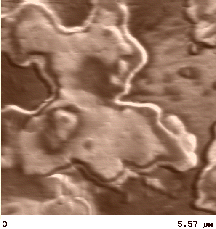Skin Cells Could Potentially Be Used To Repair the Nervous System
4 Jul, 2006 12:06 pm
Nerve cells communicate via precise electrical signals called action potentials. In order to maintain speed and intensity of these signals over long distances, specialized glial cells wrap around nerve fibres in order to form an insulative fatty sheath (called myelin). Invariably, when these myelin-forming cells are compromised by disease such as multiple sclerosis or after injury (ie. spinal cord injury), communication between the brain and the rest of the body is slowed or interrupted. Unfortunately, the brain does not replace these myelin-forming glial cells very effectively and so if enough myelin is damaged this can result in permanent disability. One potential treatment could be to use stem cells to generate new myelin-forming cells that can be transplanted into the damaged nervous system to re-myelinate damaged nerve cells.
 Stem cells are rare cells found throughout the body that show an unlimited ability to divide and are able to make multiple cell types. Our lab has been studying a stem cell from adult rodent and human skin (termed SKin-derived Precursor or “SKPS”) [1]. When grown in culture, SKPs can generate many different cell types, including fat, bone, smooth muscle, nerve cells, and Schwann cells, the specialized glial cells that myelinate the peripheral nervous system. Therefore, we asked whether SKPs might be a renewable and highly accessible source of cells that could be used to repair the damaged nervous system. Two months after transplanting SKPs into damaged peripheral nerves, we found that SKP-derived Schwann cells had wrapped around damaged or regenerating nerve fibers and made new myelin. Next, since our goal is to be able to use these cells to repair the brain and spinal cord, we also transplanted cells into the brains of mice that do not have myelin. Remarkably, we found that SKPs could also remyelinate nerve cells in the brain. Importantly, this was observed using SKPs grown from either mouse or human skin.
Stem cells are rare cells found throughout the body that show an unlimited ability to divide and are able to make multiple cell types. Our lab has been studying a stem cell from adult rodent and human skin (termed SKin-derived Precursor or “SKPS”) [1]. When grown in culture, SKPs can generate many different cell types, including fat, bone, smooth muscle, nerve cells, and Schwann cells, the specialized glial cells that myelinate the peripheral nervous system. Therefore, we asked whether SKPs might be a renewable and highly accessible source of cells that could be used to repair the damaged nervous system. Two months after transplanting SKPs into damaged peripheral nerves, we found that SKP-derived Schwann cells had wrapped around damaged or regenerating nerve fibers and made new myelin. Next, since our goal is to be able to use these cells to repair the brain and spinal cord, we also transplanted cells into the brains of mice that do not have myelin. Remarkably, we found that SKPs could also remyelinate nerve cells in the brain. Importantly, this was observed using SKPs grown from either mouse or human skin.These findings are important because they demonstrate that cells generated from SKPs (in culture) are functional when placed back into the body. But it also suggests that one’s own skin cells could potentially be used to repair the nervous system following injury or disease, avoiding any issues of immune rejection. Experiments (funded by Neuroscience Canada) are now underway to determine whether these SKP-derived Schwann cells can be utilized to repair and promote recovery following spinal cord injury.
This work was funded by the Canadian Institutes of Health Research, and the Parkinson Society of Canada.
[1] June 14, 2006 issue of The Journal of Neuroscience.






